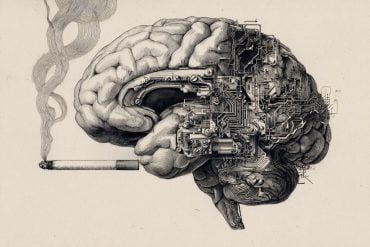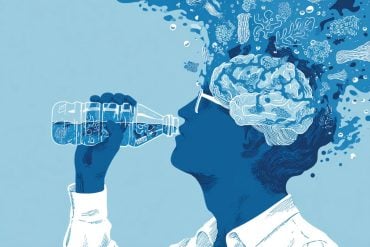Summary: Cannabinol (CBN), a cannabinoid derived from cannabis, offers neuroprotective properties that could treat neurological disorders like Alzheimer’s, Parkinson’s, and traumatic brain injuries. Their study details how CBN and its newly developed analogs prevent mitochondrial dysfunction in neurons, a common factor in these diseases.
The team synthesized four CBN-based compounds, finding one, in particular, to be highly effective in a fruit fly model of brain injury. These findings not only highlight CBN’s therapeutic potential but also pave the way for future treatments aimed at mitigating brain cell death in various neurological conditions.
Key Facts:
- CBN and its derivatives show promise in protecting neurons by enhancing mitochondrial function, crucial for preventing cell death in neurological disorders.
- The Salk team developed four new CBN analogs, with one showing significant efficacy in treating traumatic brain injury in fruit flies, indicating potential for human therapeutic use.
- This research was supported by multiple foundations and NIH grants, underscoring its significance and potential impact on treating age-related neurological disorders.
Source: Salk Institute
One in every 10 individuals above the age of 65 develops an age-related neurological disorder like Alzheimer’s or Parkinson’s, yet treatment options remain sparse for this population.
Scientists have begun exploring whether cannabinoids — compounds derived from the cannabis plant, like well-known THC (tetrahydrocannabinol) and CBD (cannabidiol) — may offer a solution.
A third, lesser-known cannabinoid called CBN (cannabinol) has recently piqued the interest of researchers, who have begun exploring the clinical potential of the milder, less psychoactive substance.

In a new study, scientists at the Salk Institute help explain how CBN protects the brain against aging and neurodegeneration, then use their findings to develop potential therapeutics.
The researchers created four CBN-inspired compounds that were more neuroprotective than the standard CBN molecule — one of which was highly effective in treating traumatic brain injury in a Drosophila fruit fly model.
The findings, published in Redox Biologyon March 29, 2024, suggest promise for CBN in treating neurological disorders like traumatic brain injury, Alzheimer’s disease, and Parkinson’s disease, and also highlight how further studies of CBN’s effects on the brain could inspire the development of new therapies for clinical use.
“Not only does CBN have neuroprotective properties, but its derivatives have the potential to become novel therapeutics for various neurological disorders,” says Research Professor Pamela Maher, senior author of the study.
“We were able to pinpoint the active groups in CBN that are doing that neuroprotection, then improve them to create derivative compounds that have greater neuroprotective ability and drug-like efficacy.”
Many neurological disorders involve the death of brain cells called neurons, due to the dysfunction of their power-generating mitochondria. CBN achieves its neuroprotective effect by preventing this mitochondrial dysfunction — but how exactly CBN does this, and whether scientists can improve CBN’s neuroprotective abilities, has remained unclear.
The Salk team previously found that CBN was modulating multiple features of mitochondrial function to protect neurons against a form of cell death called oxytosis/ferroptosis.
After uncovering this mechanism of CBN’s neuroprotective activity, they began applying both academic and industrial drug discovery methods to further characterize and attempt to improve that activity.
First, they broke CBN into small fragments and observed which of those fragments were the most effective neuroprotectors by chemically analyzing the fragment’s properties. Second, they designed and constructed four novel CBN analogs — chemical look-alikes — in which those fragments were amplified, then moved them on to drug screening.
“We were looking for CBN analogs that could get into the brain more efficiently, act more quickly, and produce a stronger neuroprotective effect than CBN itself,” says Zhibin Liang, first author and postdoctoral researcher in Maher’s lab.
“The four CBN analogs we landed on had improved medicinal chemical properties, which was exciting and really important to our goal of using them as therapeutics.”
To test the chemical medicinal properties of the four CBN analogs, the team applied them to mouse and human nerve cell cultures. When they initiated oxytosis/ferroptosis in three different ways, they found that each of the four analogs 1) were able to protect the cells from dying, and 2) had similar neuroprotective abilities compared to regular CBN.
The successful analogs were then put to the test in a Drosophila fruit fly model of traumatic brain injury. One of the analogs, CP1, was especially effective in treating traumatic brain injury — producing the highest survival rate after condition onset.
“Our findings help demonstrate the therapeutic potential of CBN, as well as the scientific opportunity we have to replicate and refine its drug-like properties,” says Maher.
“Could we one day give this CBN analog to football players the day before a big game, or to car accident survivors as they arrive in the hospital? We’re excited to see how effective these compounds might be in protecting the brain from further damage.”
In the future, the researchers will continue to screen and characterize these CBN analogs and refine their chemical designs. They will also begin looking more closely at age-related neurodegeneration and changes in brain cells, particularly in mitochondria, asking how we can better suit these drug-like compounds to promote cellular health and prevent neuronal dysfunction with age.
Other authors include David Soriano-Castell and Wolfgang Fischer of Salk; and Alec Candib and Kim Finley of the Shiley Bioscience Center at San Diego State University.
Funding: The work was supported by the Paul F. Glenn Center for Biology of Aging Research at the Salk Institute, the Bundy Foundation, the Shiley Foundation, the National Institutes of Health (R01AG067331, R21AG064287, R01AG069206, RF1AG061296, R21AG067334, NCI CCSG P30CA01495, NlA P30AG068635, S10OD021815), and the Helmsley Center for Genomic Medicine.
About this CBD and neuropharmacology research news
Author: Pamela Maher
Source: Salk Institute
Contact: Pamela Maher – Salk Institute
Image: The image is credited to Neuroscience News
Original Research: Open access.
“Fragment-based drug discovery and biological evaluation of novel cannabinol-based inhibitors of oxytosis/ferroptosis for neurological disorders” by Pamela Maher et al. Redox Biology
Abstract
Fragment-based drug discovery and biological evaluation of novel cannabinol-based inhibitors of oxytosis/ferroptosis for neurological disorders
The oxytosis/ferroptosis regulated cell death pathway is an emerging field of research owing to its pathophysiological relevance to a wide range of neurological disorders, including Alzheimer’s and Parkinson’s diseases and traumatic brain injury.
Developing novel neurotherapeutics to inhibit oxytosis/ferroptosis offers exciting opportunities for the treatment of these and other neurological diseases.
Previously, we discovered cannabinol (CBN) as a unique, potent inhibitor of oxytosis/ferroptosis by targeting mitochondria and modulating their function in neuronal cells.
To further elucidate which key pharmacophores and chemical space are essential to the beneficial effects of CBN, we herein introduce a fragment-based drug discovery strategy in conjunction with cell-based phenotypic screens using oxytosis/ferroptosis to determine the structure-activity relationship of CBN.
The resulting information led to the development of four new CBN analogs, CP1-CP4, that not only preserve the sub-micromolar potency of neuroprotection and mitochondria-modulating activities seen with CBN in neuronal cell models but also have better druglike properties.
Moreover, compared to CBN, the analog CP1 shows improved in vivo efficacy in the Drosophila model of mild traumatic brain injury. Together these studies identify the key molecular scaffolds of cannabinoids that contribute to neuroprotection against oxytosis/ferroptosis.
They also highlight the advantageous approach of combining in vitro cell-based assays and rapid in vivo studies using Drosophila models for evaluating new therapeutic compounds.







